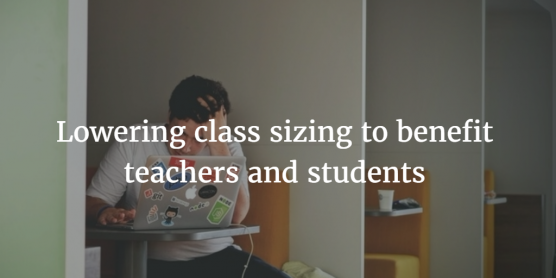The matter of class size is a formidable argument and your child’s poor academic performance may be the outcome. Studies have proven that lower class sizes, at least in the earliest grades, are linked to positive educational benefits such as better test scores, fewer dropouts and higher graduation rates, especially for disadvantaged children (2). While some believe smaller classes are optimal for kids, Lawmakers, School officials and Policy makers think otherwise. They know the benefits of class size but are too concerned with money, they agree that those benefits outweigh the costs. Now the question we should ask ourselves is, should improving schools be all about money or the education? Lawmakers as well as school officials should give adequate funding to ensure smaller class size due to its beneficiary educational outcomes for students. It ensues higher teacher focus on every student, higher participation by every student and an investment in better futures for our children. Smaller size classes are highly important and Students benefit from them more, especially students of early grade. Schools throughout the country have demonstrated that students who are assigned to smaller classes in early grade do better in every way that can be measured. Some of these ways are their higher tests scores, better grades, and they exhibit improved attendance. A cause of these achievements have to do with students having a greater opportunity to interact with their teachers as well as their peers .This gives them a feeling of trust, safety and comfortability , which makes them engage more in class .One researcher, (Frederick Mosteller) notes “Reducing [the size of classes in the early grades] reduces the distractions in the room and gives the teacher more time to devote to each child.” Most of the time the teacher’s way of teaching doesn’t change when it come to class sizes. In some cases, teachers have had some difficulties due to extremely over crowded or large classes. Education Researchers studies claim teachers generally have better morale in a small class, too, and are less likely to feel overwhelmed by having a variety of students with different backgrounds and achievement levels . As a result, they are more likely to provide a supportive environment (3). With all the many studies that have shown positive effects of class size reduction, researchers have yet found a consistent integrated explanation that’s worthy enough to convince lawmakers and policy makers to fund in smaller class sizes. Lawmakers policymakers and people who oppose class reduction, apply cost analysis to determine whether the benefits outweigh the cost. They claim that it would be more cost effective to focus on reform measures other than class size reduction, such as high academic standards, more challenging curricula, more qualified teachers, and more support for teachers (1). Another reason lawmakers are oppose by class reduction is they don’t want to hire a lot of teachers. An example of this is occurred back in 1996 in the state of California, the state had reduced class sizes. A lot of teachers were hired, a lot of them weren’t veteran teachers. This meant a lot of students weren’t getting the best education even with the reduction of class sizes. While These reasons are convincible it still doesn’t equate to the positive effects of Smaller class sizes. Evidence such as The STAR project (Students-Teacher Achievement Ratio) is a well-known study of a class size reduction program in Tennessee. The study was attended with a controlled group of 10,000 students. Classes of 22 through 26 were lowered to 13 through 17 students. In addition, the schools in the study had an adequate number of quality teachers and adequate classroom space. The project found that smaller classes resulted in substantial increases in academic performance of children in primary grades, particularly for poor and minority children. STAR Project-->
. Another source which took place, was a survey by school improvement network conducted in January 2014. This survey involved more than 5,000 educators across the U.S., representing rural, urban and suburban schools. Responders to the survey said the average class size currently is 23 students. However, these same educators put an optimally-sized classroom between 15-20 students. These surveys are implying lower size classes are optimal for both students and teachers. It is up to us, the students and parents to work our way up, to make a change in the size of classrooms in elementary as well as high school and colleges throughout the country. Simply by, lowering the size of classrooms your child’s academic performance will improve. Students and teachers would benefit more from a lower size classes. More Students will participate and engage in the classrooms, teachers will have fewer students to deal with and less distractions. Also less teachers would be unemployed.
- See more at: http://parentsacrossamerica.org/what-we-believe-2/why-class-size-matters...
1 http://www.publicschoolreview.com/blog/smaller-class-sizes-pros-and-cons
2http://www.seattletimes.com/seattle-news/education/does-class-size-matte...
3http://www.greatschools.org/gk/articles/class-size/
4http://www.nytimes.com/roomfordebate/2015/03/26/is-improving-schools-all...
http://www.publicschoolreview.com/blog/smaller-class-sizes-pros-and-cons
















